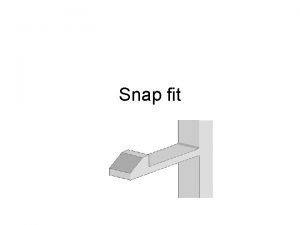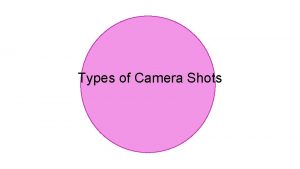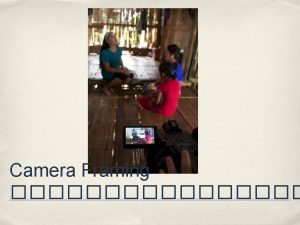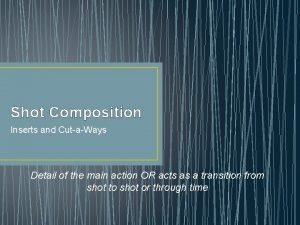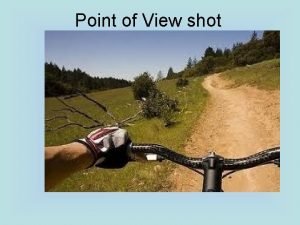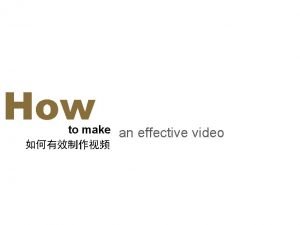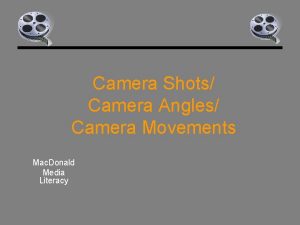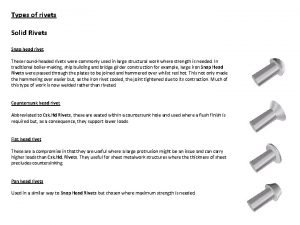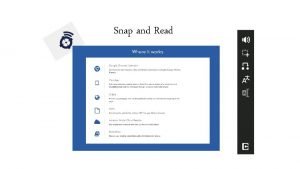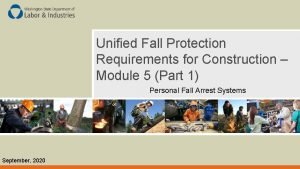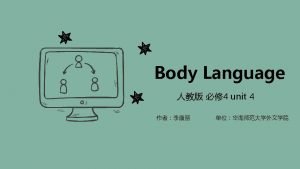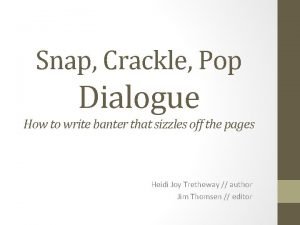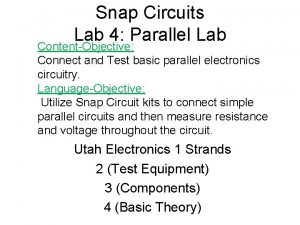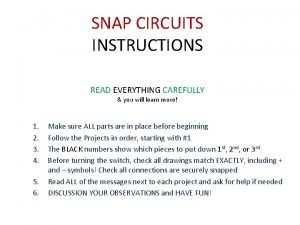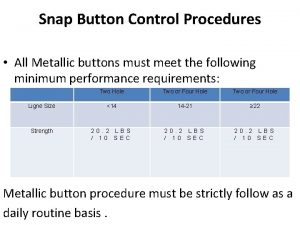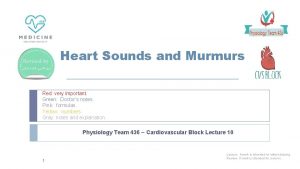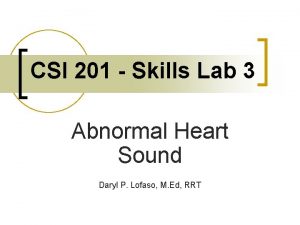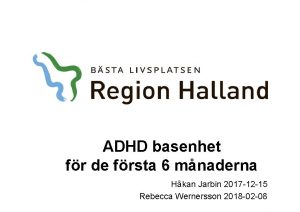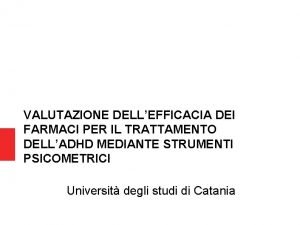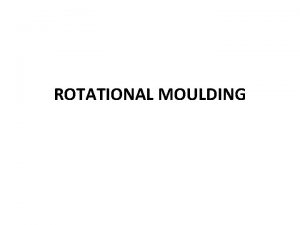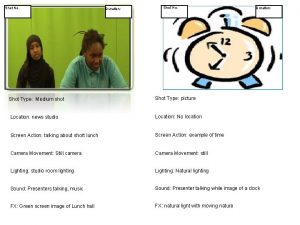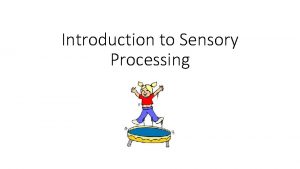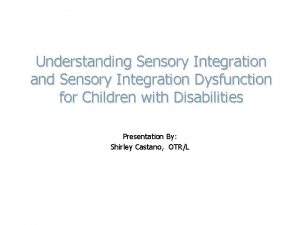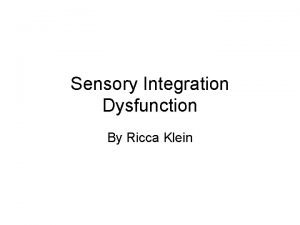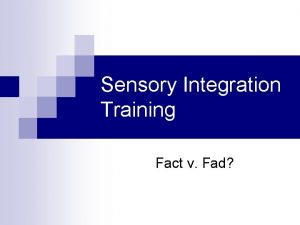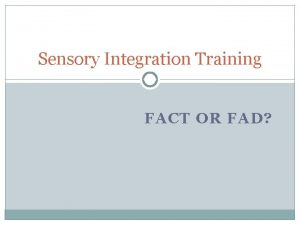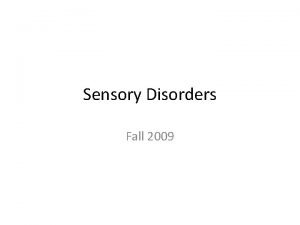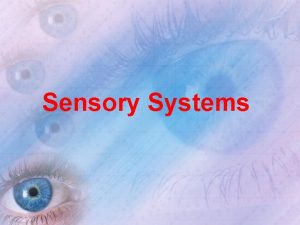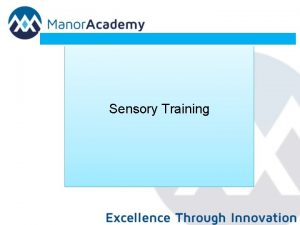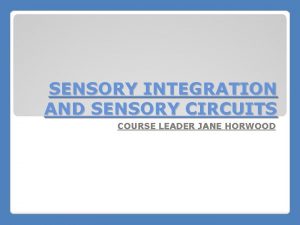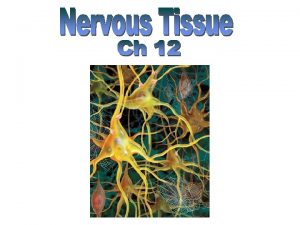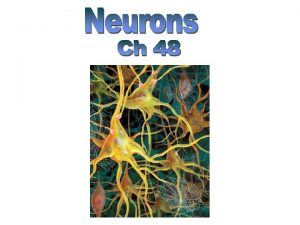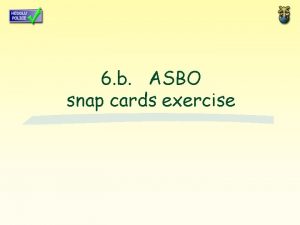Sensory Integration and ADHDa snap shot Rhona Young








































- Slides: 40

Sensory Integration and ADHD…a snap shot! Rhona Young Advanced Occupational Therapist NHS Borders

Contents • • • Sensory Integration (SI) Theory Sensory Processing Disorder (SPD) ADHD and SI difficulties OT Assessment SI based Tips

Sensory Integration Theory

Sensory Integration Theory • Developed by Dr. A. Jean Ayres throughout the 60’s, 70’s and 80’s • Strongly rooted in neuroscience • Ayres postulated three major components in her SI theory: 1 Normal development and SI in the typically developing child 2 SI dysfunction (now more commonly referred to as sensory processing disorder) 3 SI intervention approach designed to enhance neural functioning

Sensory Integration Theory • This theory was developed to increase understanding and indeed explain the relationship between behaviour and neural functioning…………. . is used to explain why individuals behave in particular ways

What is Sensory Integration…. . “the organisation of sensation for use” Jean Ayres

What is Sensory Integration? • We receive sensations from the surrounding environment and our own bodies through seven different senses: – Touch (tactile) – Detection of movement and changes in the position of head (vestibular) – Awareness of body position (proprioception) – Sight (visual) – Sound (auditory) – Smell (olfactory) – Taste (gustatory) • These sensations (input) go to the brain where they are organised and interpretated, a response (output) is then made …. THIS IS SENSORY INTEGRATION

SI Connections

Sensory Integration puts it all together. . so that, for example, when we eat an orange we have a total experience: • • • We sense the orange through our eyes (we see it) Our ears (the sound of the skin peeling) Our mouth (the taste) Our skin (on our hands and fingers and in our mouth) Our nose (the smell) and information from less conscious sensory systems that tell us. . • • The exact position of our hand How wide we open our mouth How hard to bite down How much to move our head to our hand

Why it SI so important? • 80% of the nervous system involves processing sensations • Sensations are nutrients for the brain……. sensory integration is how we digest them • Effective sensory integration helps us form a picture that is not only whole but also meaningful

Why is SI so important? • Allows us to make appropriate adaptive responses to meet the demands of the environment • Has a direct impact on learning and ability to perform

Efficient Integration. . . • Focus on stimuli you want to focus on • Deal with combinations of stimuli • Distinguish between contradictory stimuli • In other words SELF-REGULATE!!!


Sensory Processing Disorder (SPD)

Sensory Processing Disorder • • The term more commonly used now Helps to distinguish it from theory SPD is not as yet a confirmed diagnosis SPD is currently being considered for inclusion in DSMV • Global umbrella term for a hetergeneous condition with various subtypes • Affects 5% of the population • Affects 40 -80% of individuals with other developmental disabilities

The Three Primary Diagnostic Group of Sensory Processing Disorder Type III Sensory Discrimination Disorders Type I Sensory Modulation Disorders Type II Sensory Motor Based Disorders Taken from Schaaf and Miller, (2005, p. 3)

Primary Sensory Processing Types and Subtypes Type of SPD Subtypes Type I Sensory Modulation Disorder (SMD) (Refers to difficulty regulating responses to sensory stimulation) 1. Sensory Over Responsive (SOR) 2. Sensory Under Responsive (SUR) 3. Sensory Seeking / Craving (SS) Type II Sensory Based Motor Disorder (SBMD) 1. Postural Disorder – problems in balance and core stability 2. Dyspraxia – difficulties with motor planning and sequencing movements Type III Sensory Discrimination Disorder (SDD) Difficulties interpretating the specific characteristics of sensory stimuli. Can be present in any of the seven sensory systems. Devised from the work of Miller, cited in Kennedy, (2009) and Tanenbaum, (2010), Miller et al, (2009).

ADHD and SI Difficulties

ADHD and SI Difficulties • Many children with ADHD present with SI difficulties…why? . . . . • The development and functioning parts of the brain have been affected…. . therefore…. . • Sensory input does not get to the brain correctly and/or the correct neurological connections are not being made • Responses are therefore different from what is expected

ADHD and SI Difficulties There is a typical pattern of sensory based difficulties children with ADHD have: • • • Sensory seeking behaviours Sensory avoiding behaviours Sensory sensitivities Addition to this, children with a diagnosis of ADHD can also have SPD According to Miller (2006) this is around 60%

Sensory v Behaviour Sensory difficulties can be misconstrued as behavioural problems e. g. – – – Inattention Distractibility Motor coordination Hypersensitivity Emotional difficulties • When a sensory problem exists, it is often accompanied by behavioural concerns or coping strategies that also must be addressed • If we make the mistake of only addressing the behavioural aspect of the problem, the base sensory problem will still exist and the child may become frustrated, act out in different more intense ways or project a feeling of uneasiness, as if something is about to erupt

ADHD and SI • Inability to modulate sensory input: – Can take in too much or too little – Difficulties adjusting the intensity and duration of stimuli – Difficulties filtering out the unnecessary • Inability to register and discriminate: – Responses to stimuli – Ability to distinguish • Difficulties with praxis: – Ability to plan new movements • Difficulties with language and emotions • Indicated by (Individual Presents by): – – – Over or under responding to certain sensory experiences Having movement difficulties Having visual difficulties Having language difficulties Having emotional liability

ADHD and SI • Activity level usually high • Arousal/Regulation Problems – seeking more movement to get to the just right level – vestibular and proprioceptive input – More hyperactive, more distractible, more impulsive • Need more stimulation – sound - often make noise for noises sake – mouthing objects • Over or under respond to: – – Touch Movement Sight Sound

ADHD and SI • Avoids certain food textures and tastes • Difficulty blocking out stimuli that is not required – Poor attention/concentration • Abnormal motor output with abnormal feedback – Gross and Fine Motor Problems – Motor planning difficulties • Social and/or emotional difficulties • Poor Organisation of behaviours – Difficulty in completing multiple step activities

OT Assessment

Assessment • The therapist must have training in sensory integration • Occupational Therapists, Physiotherapists and Speech and Language Therapists may have training in this area • The therapist uses careful assessment to determine which parts of the Sensory Integration process require intervention

Assessment Process • Developmental and sensory history • Consult with other involved professionals • Observational Assessment – Child’s sensory reactivity and organisation – Components of the sensory environment and effects on behaviour – Child’s responses

Assessment Process • Standardised assessment tools – Sensory Profile (5 -10 yrs) (Dunn 1999) – Sensory Profile School Companion (Dunn 2006) – Measures a child’s sensory processing abilities and to ascertain the effect of sensory processing on functional performance • Clinical Observations – Set of observations developed to evaluate a child’s level of function and maturation. It is used to determine the need for therapy and what intervention approach is more appropriate and effective

SI based Tips

Tips for in the Clinic • Have some fidgets available as these help individuals to concentrate on what you are saying • Have access to movement cushions/chair balls if the individual is expected to sit for a long period • Have a beanbag in the corner with some heavy pillows

Quick Tips to give to Parents • Chewlery is good for the children who orally sensory seek • Movement cushions are great for use at the dinner table • Weighted neck wraps are good for settling before bed and for use during the day at school • Headphones are great for blocking out unnecessary stimuli during homework

SI Tips for Sleep Hygiene • Sleep – – – – Massage Vibrating pillow Vibrating toothbrush Weighted blankets (10% of body weight) Sleeping bag Long, firm hugs Tighter PJs • Wake up – Favourite music

Heavy Work Suggestions • • • • Carrying heavy items (shopping in from the car, putting the rubbish out) Chewing gum, eating chewy or crunchy foods, and sipping water from a water bottle are all can have a calming and organising effect Milkshake or smoothie sipped through a narrow straw, again can have a calming and organising effect Pushing, pulling, and lifting boxes Garden work Housework Pushing in chairs under the table after a meal and wipe off the table Open doors for people Wash the car Shopping - push the shopping trolley filled with items, carry in the shopping Sports activities involving running, jumping, climbing, dancing. Activities such as gymnastics, horse riding, wrestling, karate, swimming Supervised wood projects requiring sanding and hammering The aim is to incorporate these activity ideas into your family life and therefore they are flexible to your family’s needs and time – most of all remember to have fun!

Movement Tips Ideas when sitting at your desk • Chair push-ups: place your hands at the sides of the chair and lean slightly forward. Then using your arms, lift your body off the chair. Repeat 5 times. • Desk pushes: place your hands on the desk and push your hands into the desk for 10 seconds and then release. Repeat 3 times. • Feet Presses: press your feet into the ground for 10 seconds and then release. Repeat 3 times. • Stretching • It is often very helpful to have your hands engaged when you are concentrating. Fidgeting can be helpful for attention and focus. Make use of your chewlery fidget. • Hand push: Place your hands together and press for 10 seconds. • Fists: make a fist and then release, do this 10 times on each hand • Drumming your Fingers: this needs to be quiet, so instead of doing it on the table, try doing it on your leg.

Things to get Parent’s and Education staff to consider • Observation – Vital tool • Environment – – – Stimuli Colour Calm space Active space Work stations

• Final Thoughts SI theory: – Is useful for understanding the brain behaviour relationship – Is vital to interpreting the information that confronts individuals at all times – Plays a crucial role in child development • ADHD and SI Difficulties – We need to consider these and provide intervention • SPD – Helpful diagnostic term to understand the functioning of some individuals – We need to consider this when assessing for ADHD

Contact Details Rhona Young Advanced Occupational Therapist The Andrew Lang Unit, Viewfield Lane, Selkirk, TD 7 4 LJ, SCOTLAND, TEL: 01750 23715 rhona. young@selkirkhc. borders. scot. nhs. uk

References • • Ayres, A. J. 2005. Sensory Integration and the Child: 25 th Anniversary Edition. Los Angeles, CA: Western Psychological Services Publishers. Kennedy, A. 2009. Sensory Integration and Autism http: //www. annakennedyonline. com/page. aspx? id=241 Miller, L. J, 2006. Sensational Kids: Help and Hope for Children with Sensory Processing Disorder New York, NY: GP Putnam Sons. Miller, L. J, Anzalone, M. E, Lane, S. J, Cermak, S. A. and Osten, E. T. 2007 a. Concept Evolution in Sensory Integration: A Proposed nosology for Diagnosis The American Journal of Occupational Therapy 61(2) pp. 134 -140. Miller, L. J, Coll, J. R. and Schoen, S. A. 2007 b. A randomised Controlled Pilot Study of the Effectiveness of occupational Therapy for Children With Sensory Modulation Disorder. The American Journal of Occupational Therapy 61(2) pp. 228 -238. Miller, LJ and Lane, SJ. 2000. Toward a Concensus in Termonolgy in Sensory Integration Theory and Practice: Part One: Taxonomy of Neurophysiological Processes sensory Integration Special Interest Section Quarterly 23(1) pp. 1 -4. Miller, L. J, Nielsen, D. M, Schoan, S. A, and Brett-Green, B. A. 2009. Perspectives on Sensory Processing Disorder: A Call for Translational Research Frontiers in Integrative Neuroscience (3) Article 22 pp. 1 -12. Miller, L. J, Schoen, S. A, James, R, and Schaaf, R. C. 2007. Lessons Learned: A Pilot Study on Occupational Therapy Effectiveness for Children With Sensory Modulation Disorder The American Journal of Occupational Therapy 61(2) pp. 161 -169.

Helpful Websites • • • www. specialdirect. com www. thesensorycompany. co. uk www. rompa. com www. winslow-cat. com www. nrs-uk. co. uk www. sensoryintegration. org. uk www. addiss. org. uk www. adders. org www. southpaw. com

Time for your questions
 Filing snap fit snap partner maylundentechcrunch
Filing snap fit snap partner maylundentechcrunch Rhona hotchkiss
Rhona hotchkiss Rhona millar
Rhona millar Medial and lateral apertures
Medial and lateral apertures Point of view shot
Point of view shot Camera angle types
Camera angle types Camera framing
Camera framing What is cutaways
What is cutaways What is a subjective pov
What is a subjective pov Kortfilmsanalyse
Kortfilmsanalyse Wide shot medium shot close up
Wide shot medium shot close up Long shot camera shot
Long shot camera shot Forward integration and backward integration
Forward integration and backward integration Vertical diversification example
Vertical diversification example Integration
Integration Pan head rivet uses
Pan head rivet uses What does abawd mean
What does abawd mean Snap and read
Snap and read Personal fall arrest snap hooks must be locking and be
Personal fall arrest snap hooks must be locking and be If you're happy and you know it stomp your feet
If you're happy and you know it stomp your feet Snap cloud
Snap cloud Question list for snap
Question list for snap Snap survey software
Snap survey software Snap fistula
Snap fistula How to write banter
How to write banter Objectiveconnect
Objectiveconnect Snap circuit manual
Snap circuit manual Pinch setting for snap
Pinch setting for snap Snap fit
Snap fit Diastolic murmur
Diastolic murmur Snap.sdbor.edu
Snap.sdbor.edu Diastolic murmur with opening snap
Diastolic murmur with opening snap Snap-iv ålder
Snap-iv ålder Diagnosn
Diagnosn Objectives of decision making
Objectives of decision making Chrome river audit
Chrome river audit Percy jackson lotus casino chapter
Percy jackson lotus casino chapter How to use snap coins
How to use snap coins Scotch snap example
Scotch snap example Snap iv rating scale
Snap iv rating scale Rotational moulding advantages and disadvantages
Rotational moulding advantages and disadvantages
